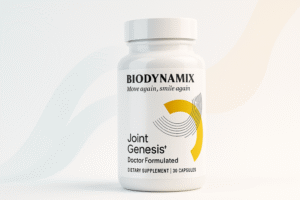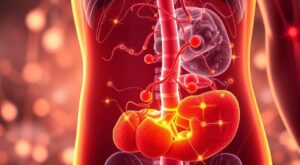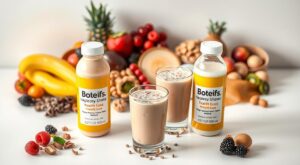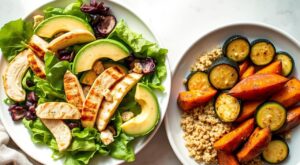Ever thought a simple diet change could boost your digestive health? A weekly high fiber meal plan might be the answer. It’s all about adding fiber-rich foods to your daily meals.
This article will show you how a fiber-rich meal plan can improve your health. It supports healthy digestion and prevents discomfort. You’ll find tasty meal options that are good for your gut, leading to a healthier you.
Importance of a High-Fiber Diet for Gut Health
It’s key to know how vital a high-fiber diet is for your gut health. Many don’t realize how much fiber affects their health. Fiber helps your body digest food well, keeping it running smoothly. Adding fiber to your meals boosts your health and happiness.
What Is Fiber and Why You Need It
Fiber is a carb your body can’t digest. It comes in two types: soluble and insoluble. Soluble fiber helps control blood sugar and keeps you full. Insoluble fiber helps with bowel movements, keeping your gut healthy. A high-fiber diet is important for regular bowel movements and better nutrient absorption.
Benefits of Fiber for Digestion
Fiber does more than just help with digestion. It lowers the risk of heart disease, type 2 diabetes, and colon cancer. It also helps you feel full, making it easier to stay at a healthy weight. Plus, it feeds good gut bacteria, improving digestion and nutrient use.
Common Sources of Dietary Fiber
Finding fiber in your diet is easy. Eat more fruits, veggies, whole grains, and legumes. Here’s a list of foods high in fiber:
- Fruits like apples, bananas, and berries
- Vegetables like broccoli, carrots, and leafy greens
- Whole grains, including oats, quinoa, and brown rice
- Legumes like lentils, beans, and chickpeas
By eating these foods, you’ll enjoy the many perks of a high-fiber diet.
How to Use This Meal Plan
Starting a high-fiber meal plan is easier than you think. Begin by slowly adding more fiber to your diet. This lets your body get used to it while you try different high-fiber foods. This way, every meal will be more filling and healthy.
Tips for Incorporating Fiber into Your Diet
Here are some tips to make your meals fiber-rich:
- Opt for whole grains like brown rice, quinoa, and whole grain pasta. They are packed with fiber.
- Add a variety of fruits and vegetables to your meals. Berries, apples, carrots, and leafy greens are great choices.
- Legumes like lentils, chickpeas, and beans are not only high in fiber but also in protein.
- Choose high-fiber snacks like popcorn, nuts, or seeds instead of processed ones.
Tracking Your Fiber Intake
Keeping track of your fiber intake is key. Use apps or food diaries to log what you eat. This helps you see how much fiber you get each day. It also keeps you on track with your dietary goals.
Understanding Serving Sizes
Knowing the right serving sizes for fiber is important. The amounts can vary, so always check nutrition labels. For example:
| Food Item | Serving Size | Fiber Content |
|---|---|---|
| Chia Seeds | 1 ounce (about 3 tablespoons) | 10 grams |
| Oats | 1 cup cooked | 4 grams |
| Black Beans | 1/2 cup cooked | 7.5 grams |
| Broccoli | 1 cup cooked | 5 grams |
Knowing these serving sizes helps you manage your fiber intake. This way, you can enjoy the many benefits of a high-fiber diet.
Your Weekly Meal Plan Overview
Eating a variety of fiber-rich foods is key to meet your daily fiber goals. This meal plan helps you get 25-30 grams of fiber daily. It makes sure your meals are tasty and healthy. Cooking in batches and using leftovers can make things easier.
Quick Reference for Daily Fiber Goals
Each day, this plan includes meals high in fiber. Here’s a quick guide to your fiber goals for each day, along with calorie intake:
| Day | Calories | Protein (g) | Fiber (g) |
|---|---|---|---|
| Day 1 | 1,514 | 85 | 30 |
| Day 2 | 1,517 | 103 | 31 |
| Day 3 | 1,519 | 82 | 31 |
This table shows how the meal plan helps you reach your fiber goals. It ensures your diet is balanced and healthy.
Sample Grocery List for the Week
Having a good grocery list makes shopping easy. Here’s a list for fiber-rich meals to start your week:
- Fruits: Apples, pears, strawberries
- Vegetables: Spinach, kale, carrots
- Grains: Quinoa, brown rice, whole grain bread
- Legumes: Lentils, chickpeas, black beans
- Nuts and seeds: Chia seeds, almonds, walnuts
- Probiotic-rich foods: Yogurt, kefir
For more meal ideas, check out the weekly meal plan overview. It keeps your meals fun and supports your high-fiber diet.
Delicious High-Fiber Breakfast Ideas
Starting your day with a high-fiber breakfast is great for your digestive health. Fiber-rich foods keep you full and provide important nutrients. Here are some tasty and healthy ways to start your day.
Overnight Oats with Fruits and Nuts
Overnight oats are a favorite for a fiber-packed breakfast. They’re easy to make and you can change them up. Mix rolled oats with milk, yogurt, or plant-based options, then soak them overnight. Add fruits like berries or bananas and nuts for extra fiber and crunch.
Chia Seed Pudding Variations
Chia seed pudding is another great choice. Chia seeds turn gelatinous when soaked, making a creamy base. Mix them with milk and let them sit for a few hours or overnight. You can add vanilla, cocoa, or sweeteners, then top with fruits or granola. This breakfast is full of fiber and omega-3s, boosting your health.
Whole Grain Toast Toppings
Whole grain toast is versatile for boosting fiber. Try avocado for healthy fats and fiber, or nut butter with banana slices. These combos are delicious and give you energy all morning.

| Breakfast Ideas | Key Ingredients | Fiber Content (approx. per serving) |
|---|---|---|
| Overnight Oats | Rolled oats, milk, fruits, nuts | 8g |
| Chia Seed Pudding | Chia seeds, milk, flavors, toppings | 10g |
| Whole Grain Toast | Whole grain bread, toppings | 5-7g |
Try these high-fiber breakfast ideas to nourish your body and support your digestive health. Enjoy experimenting with flavors while focusing on your wellness every morning.
Nutritious High-Fiber Lunch Options
Adding high-fiber lunch options to your diet can boost your health. These meals are not only fiber-rich but also taste great. Try a quinoa salad for a fresh veggie fix or lentil soup for a warm, nourishing meal. Whole grain wraps are also a great choice for busy days.
Quinoa Salad with Vegetables
Quinoa salad is a great pick for a nutritious lunch. It’s full of protein and fiber, and you can add your favorite veggies. Mix in bell peppers, cucumbers, and cherry tomatoes. Add olive oil and lemon juice for a tasty twist. You can make it ahead of time and grab it all week.
Lentil Soup Recipes
Lentil soup is a hearty way to get your fiber. Lentils are packed with protein and fiber, making them perfect for a high-fiber diet. Try adding spices, herbs, or coconut milk for extra flavor. A bowl of lentil soup is comforting and filling, perfect for cold days.
Wraps Made with Whole Grain Tortillas
Whole grain tortilla wraps are a convenient high-fiber option. Fill them with lean proteins, veggies, and healthy fats for a balanced meal. Use turkey, hummus, or avocado for extra flavor. Add fruit or a small salad for even more fiber.
These lunch ideas not only help with digestion but also keep you full and energized. For more high-fiber meal ideas, check out this resource.
Satisfying High-Fiber Dinner Recipes
Dinnertime can be a delightful experience filled with satisfying high-fiber dinner recipes. These recipes not only taste great but also support your digestive health. Here are some easy-to-prepare options that will leave you feeling full and nourished.
Stir-Fried Brown Rice with Vegetables
Stir-fried brown rice can be a colorful, nutrient-dense choice for your evening meal. Combine this whole grain with an assortment of fresh vegetables like bell peppers, broccoli, and carrots. This combination offers a plethora of vitamins and adds richness to your dish.
Drizzle some soy sauce or teriyaki for an extra flavor kick. Enjoy a wholesome and filling dinner.
Black Bean Tacos on Corn Tortillas
Black bean tacos on corn tortillas are a flavorful way to include more beans in your diet. Prepare your black beans with spices such as cumin and coriander for an added burst of taste. Load the tacos with your favorite toppings like avocado, salsa, and shredded lettuce.
These tacos not only present a delightful texture but also serve as a great source of fiber. Making your meal both enjoyable and fulfilling.
Baked Sweet Potatoes with Toppings
Baked sweet potatoes offer versatility in your meal options. These are naturally high in fiber and can be customized with a range of toppings. Consider adding Greek yogurt, black beans, or a sprinkle of cheese.
This dish provides both a comforting end to your day and a nourishing boost to your fiber intake.
| Recipe | Key Ingredients | Fiber Content (per serving) |
|---|---|---|
| Stir-Fried Brown Rice | Brown rice, mixed vegetables | 5g |
| Black Bean Tacos | Black beans, corn tortillas, toppings | 8g |
| Baked Sweet Potatoes | Sweet potatoes, various toppings | 4g |

Healthy Snack Choices to Boost Fiber
Choosing the right snacks is key to meeting your daily fiber goals. High-fiber snacks keep hunger away and provide vital nutrients. Here are some healthy snack options that boost energy and support digestion.
Fresh Fruits and Vegetables
Fresh fruits and veggies are top fiber sources. Try apples, pears, berries, and carrots for a crunchy, sweet snack. These quick, nutritious bites are full of vitamins and minerals, too.
High-Fiber Protein Bars
High-fiber protein bars are great for busy days. Many brands offer tasty, fiber-rich options. Choose bars with whole grains and natural ingredients for a satisfying snack.
Popcorn as a Snack Option
Popcorn is a tasty whole grain snack. Air-popped popcorn is low in calories and high in fiber. You can season it to your liking. It’s a healthier choice than processed snacks.
Hydration and Fiber: A Key Relationship
It’s important to understand how hydration and fiber work together for better digestion. Eating more fiber helps your bowels work better. But, you need to drink more water too. Drinking enough water helps your digestion run smoothly and keeps you comfortable.
Importance of Drinking Water
Drinking water is very important, even more so when you eat more fiber. Water helps fiber move through your body well. Not drinking enough water can cause problems like bloating and constipation.
How Fiber Absorbs Water
Fiber absorbs water, making your stools softer and bowel movements easier. Without enough water, fiber can’t work as well. So, eating fiber and drinking water together is key to a healthy digestive system.
Tips for Staying Hydrated
Staying hydrated can be hard, but here are some easy tips:
- Carry a reusable water bottle to remind yourself to drink all day.
- Set goals for how much water you want to drink, like before meals or every hour.
- Try adding fruits or herbs to your water for a tasty twist.
By drinking enough water, you help your fiber-rich diet work better. For more tips on eating well, check out this high-protein meal plan.

Overcoming Common Digestive Issues
Many people face digestive problems like bloating and gas, often when they eat more fiber. Knowing how your body reacts is key to managing discomfort. This knowledge helps you find the right bloating remedies and adjust your diet.
Understanding Bloating and Gas
Bloating happens when gas builds up in your stomach. It can be caused by eating fast, certain foods, or swallowing air. Notice which foods make you uncomfortable. This can help you avoid them and ease your symptoms.
Tips for Easing Digestive Discomfort
There are simple ways to feel better. Start with a small amount of fiber and slowly add more. This lets your body get used to it. Also, chewing your food well helps digestion and can lessen bloating.
Drinking plenty of water is also important. It helps fiber move smoothly through your body. If you’re not feeling better, seeing a healthcare professional for gut issues can help. They can give you advice that fits your specific situation.
When to Consult a Healthcare Professional
If bloating and other digestive problems keep coming back, it’s time to see a doctor. They can offer advice, suggest treatments, and check for any hidden health issues. Taking care of your health is important, even when dealing with ongoing digestive problems.
Adjusting to a High-Fiber Diet
Starting a high-fiber diet can seem daunting, but it’s easier when you take it slow. Adding fiber gradually helps your body adjust without discomfort. This process teaches you to listen to your body as you change your diet.
Gradual Inclusion of Fiber
Begin by slowly adding fiber to your meals. Try to increase your fiber intake by 5 grams each week. This gradual increase helps your body get used to more fiber without upset.
Listening to Your Body
It’s important to notice how your body reacts to new fiber. If you feel bloated or gassy, it might mean you’re adding too much too fast. Adjust your fiber intake based on how you feel to ensure a positive experience.
Maintaining Balance in Your Diet
A high-fiber diet should not neglect other nutrients. Make sure to eat a variety of foods that are rich in vitamins and minerals too. This balance supports your digestive health and overall well-being, making your journey to a healthier lifestyle more rewarding.

Long-Term Benefits of a High-Fiber Lifestyle
Choosing a high-fiber lifestyle can greatly improve your health over time. It not only makes your gut happier but also lowers the risk of many chronic diseases. Eating foods rich in fiber gives you a strong base for better health.
Improved Digestive Health
Fiber is key for good digestive health. It makes your stool bulkier and helps you go to the bathroom regularly, cutting down on constipation. Eating foods high in fiber supports your body’s natural digestion, leading to a healthier gut.
Reduced Risk of Chronic Diseases
A diet rich in fiber can lower your risk of heart disease, diabetes, and some cancers. Adding fiber to your meals helps keep your blood sugar stable and cholesterol low. This is good for your heart. The long-term benefits of eating fiber make it a must-have in your diet.
Enhanced Overall Wellbeing
Eating a fiber-rich diet does more than just help your body. It also boosts your mood and energy levels. This is because fiber helps keep your blood sugar steady. This mix of physical and emotional benefits leads to a better overall sense of wellbeing.
Conclusion and Next Steps
As you finish this weekly high-fiber meal plan, take a moment to reflect on your health journey. You’ve made a big commitment to your diet, which can greatly improve your digestive health. Celebrate every small step you’ve taken towards wellness.
Look for more fiber resources to help you on your journey. They offer great recipes, cooking tips, and diet advice. Using this information daily can help you stick to your high-fiber diet. Knowledge is key to reaching your health goals.
It’s important to keep up with these dietary changes for lasting benefits. Every step towards a healthier diet improves digestion and boosts your lifestyle. Keep going and remember the positive changes you’re making in your life.













